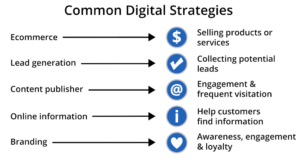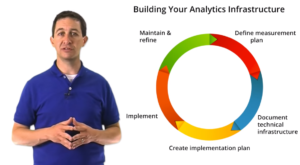The post today is about my journey to get certified with Google Analytics. The training for this certification was, in my opinion, much more robust than the Adwords course materials. There were videos with Justin Cutroni, the Digital Analytics Evangelist at Google, that were well done and had great information. I feel that I retained the information presented much better than I did with the Adwords training. This could be due to a couple of factors.
- I think I retain information better when presented in video form. This illustrates the importance of having videos to accompany your text materials when instructing people.
- The concepts were much more closely aligned with my experience with Marketing Automation concepts in general. It is tracking, after all, and we talk a lot about how to segment and report on the information you gather when using MA tools.
Digital Analytics Fundamentals
I tackled this section on my first day. I’d like to highlight a few of items Justin covered in his videos, that stuck out to me during the training.
- Justin did a great job of covering why you need analytics for your business. He also pointed out that there are many different types of campaigns, all used for very specific strategies. Here are some sample digital strategies that he highlighted.

- It’s important to have a direction when setting up analytics of any kind. Here is a nice graphic from the presentation that shows how to set up that plan and then how it is continually refined.

- Justin also talked about the importance of having a measurement plan. I feel that sometimes businesses don’t know where to start. Well, here are some steps to point you in the right direction
- Step 1: Document business objectives
- Step 2: Identify strategies and tactics
- Step 3: Choose KPIs
- Step 4: Choose Segments
- Step 5: Choose targets
Google Analytics Platform Principles
The first section took me the better part of a day to get through as I was doing other things as well. It was good information, though, and helped lay the groundwork to understand the rest of the series. Here are some interesting things I discovered while going through the Google Analytics Platform Principles section the next day.
- Filters permanently change the data that is processed. This is why they suggest you set up different Views within your different properties. I feel that Marketing Automation systems may have an edge here because they keep all the data collected. MA system reports may be slower to generate due to this approach, but I feel that is a fair trade-off to maintain data integrity. I’d much rather have access to the data than see some of it get lost. So Filters in Google Analytics reports are very different that what I’ve known as filters in Marketing Automation reports.
- I really like the concept of Attribution Models in Google Analytics. Assigning conversion credit for sales to given touchpoints is something that marketers are looking for every day. It helps them determine whether their marketing efforts are paying off or not. Google lets you give credit how you want. The default is “Last Interaction” but you can have First Interaction, Linear, Time Decay or even custom models that you create. This is something more MA platforms need to pay attention to.
Ecommerce and Mobile App Analytics
These sections were focused on these two specific types of reporting. I didn’t see a lot about these sections during the certification test so I’m not sure if they were worth going over other than for general knowledge. They are quick sections, however, so I’d say it’s worth watching the videos to be familiar with the reporting and capabilities for these types of sites.
Overall, I did learn a lot of good information. Analytics is so much more than just keyword reports for your site. I recommend getting familiar with what Google Analytics can do to anyone who wants any sort of information on their website or app performance. It’s not just for marketers. There is plenty of information that can be useful to all business entities and you would do yourself a favor by becoming familiar with how this data is collected.
Did I pass? Yeah, I did. 🙂



